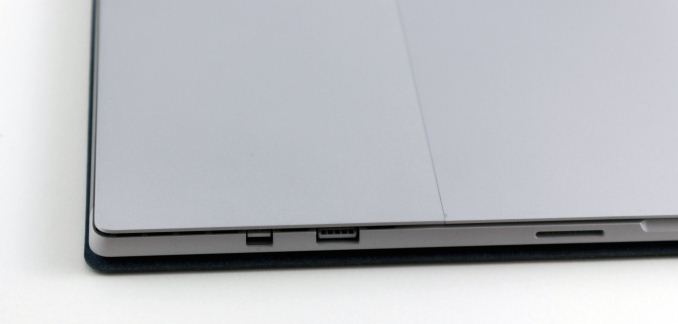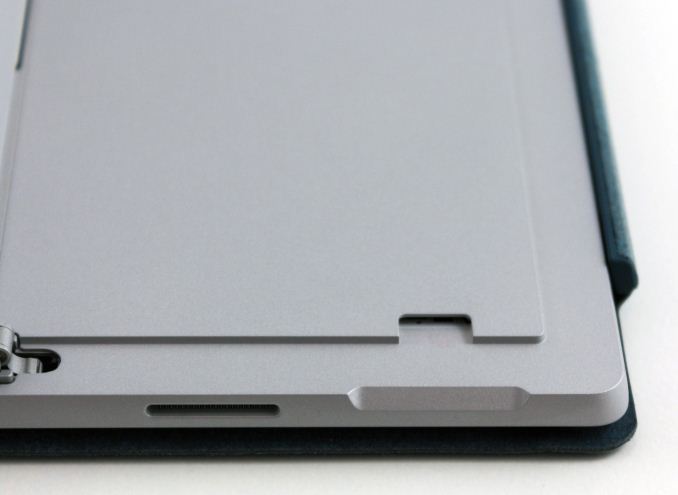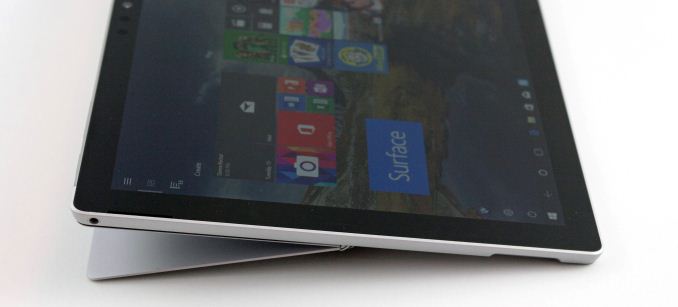The Microsoft Surface Pro (2017) Review: Evolution
by Brett Howse on June 15, 2017 9:00 AM ESTDesign
The Surface Pro 3 brought about a revolution in the design of the Surface Pro family, bringing the 3:2 aspect ratio that is now the signature on all Surface devices, as well as a much thinner and lighter design. Surface Pro 4 evolved that design, bringing a slightly larger display into the same size chassis, while becoming a bit thinner and lighter again. The new Surface Pro continues that evolution-rather-than-revolution philosophy, and that’s arguably the right choice for a successful product.
The latest design has softened the exterior, moving away from the angular design that has been a part of Surface Pro since the beginning. The edges are now slightly rounded, but without radically changing the look. The new rounded sides provide an improved in-hand feel, without the uncomfortable sharpness of the older generations.
The design is familiar though, with the same silver color on the chassis, along with a thin plastic RF window at the top, where the power and volume controls are. The left-side features the 3.5 mm headset jack, the right-side features all of the ports, and the bottom has the keyboard connector.
Speaking of the ports, they are exactly the same as the Surface Pro 4. There’s a USB-A port, a mini DisplayPort, and the Surface Connect for power and expansion. For those that need to add a bit more storage, the new Surface Pro continues to offer a micro SD slot too.
The lack of USB-C with Thunderbolt 3 in a high-end 2017 device is definitely a knock against the new Surface Pro. Microsoft’s reasoning is that USB-C is a port with too many options, and no two ports are guaranteed to be the same, which will lead to customer confusion. There’s also the argument that most of our devices still use full-sized USB, so Microsoft has stuck to its guns and just kept the USB-A port. They aren’t wrong about USB-C being confusing, though. Other than USB data, which is the one thing that all USB-C should support – although not always at the same speed – ports can support displays, higher power levels, Thunderbolt 3, and more. The counterpoint to this argument is that Surface Pro could offer a USB-C that features everything, although it would cost not only in terms of actual cost, but also space for extra chips, and in a small device like the Surface Pro, space is at a premium.
Their other argument is that, at least currently, almost anything that connects to USB-C needs an adapter or dongle of some sort, and that’s also true. But the counter to that is that the Surface Pro features a mini DisplayPort, which arguably needs a dongle or special cable to connect to almost anything anyway. A USB-C could offer the same DisplayPort signal, but way more.
There’s no argument that keeping the USB-A port is the right idea for today, but it would have been nice to see Microsoft adopt the new standard for the future, since a device with this kind of price has to have the expectation that it will still be around in several years, when USB-C will be more widespread.
The Kickstand
The one area that Microsoft both pioneered – and continued to evolve – is the kickstand. Looking back at the original Surface devices, the kickstand really the key to the entire device, allowing Surface to quickly and easily be used as both a tablet, and a laptop. The latest kickstand improves everything, again.
The biggest change is that the kickstand now opens even wider. The opening arc increases from 150° to 165°, which gives the Surface Pro an even better platform for using the Surface Pen, and accessories like the Surface Dial, which works right on the display, just like the Surface Studio.
The new kickstand seems to be even smoother than the Pro 4, and still offers just the right amount of friction to not allow the Pro to change angles when using touch on the display.
The kickstand is still one of the signature features of the Surface Pro, and it’s great to see it continue to improve.
Cooling Upgrades
The Surface Pro 4’s cooling was a big improvement over the Surface Pro 3, greatly reducing CPU thermal throttling, but also being quieter. The new Surface Pro develops on this again. When the Surface Pro 4 launched, the engineers let us know that they felt that the cooling system could dissipate the full 15-Watts of heat from the CPU passively, but they still included the fan on both the Core i5 and Core i7 models for the Surface Pro 4.
The new Surface Pro ditches the fan completely on the (15W) Core i5 model now, leaving just the (15W) Core i7 model with active cooling. Microsoft hasn't yet sampled this model of the Surface Pro, but hopefully we’ll be able to test it out soon to see what ramifications that changes has for performance. For noise though, it’s all good news, since it should be practically silent.
The Core i7 model, that we do have for review, is even quieter than the outgoing Pro 4, especially when at its default settings. So despite the active fan, the cooling system is much quieter. The cooling vents have been changed as well, with a much more subtle look to them on the new Pro.
The cooling changes have all been positive, and we’ll check out the performance of them later in the review.













124 Comments
View All Comments
ivan.lazarenko - Friday, June 16, 2017 - link
Brett, thank you for the great review! This evolution approach for new Microsoft Surface Pro is a pretty lame version of what the fans were expecting to be a true successor, the real Surface Pro 5You might like this video hits like the last nail in the coffin and is funny: https://www.youtube.com/watch?v=f3sC82vnR7A
UtilityMax - Saturday, June 17, 2017 - link
I have never been fan of a "laptop" that's as unstable on your laps as the Surface Pro 4, and a "tablet" that's as thick as heavy as the Surface Pro, and with such relatively poor touch GUI and the lack of much tablet apps. In other words, it was a poor laptop, and a poor tablet. The new one looks like more of the same. I'd rather by myself a Lenovo Yoga 700 or 900-series ultra-tin laptops foldable keyboard (yes, real keyboard, not keyboard "covers")serendip - Saturday, June 17, 2017 - link
Unfortunately yes, most tablets make poor laptops. Large Windows tablets also make poor tablets because they're heavy and Windows still isn't touch friendly. I'm a masochist who loves traveling light so I don't mind rocking a cheap Teclast Windows tablet. I couldn't justify spending on a Surface when it costs so much and it doesn't know what it is.damianrobertjones - Friday, August 18, 2017 - link
Why does it have to be defined as either one?mkozakewich - Saturday, June 17, 2017 - link
Okay, so there's never been anything more than rhetoric flying around about the pens. "Oh, it's so much better now!" It sounds good, but then I also hear people swear by the Apple Pencil. Is it possible to benchmark those kinds of things? Would it be possible for you to measure activation forces various pens, as well as maybe latency and pressure-levels-per-gram-of-force?Also, was the original Type Cover Alcantara? I haven't seen a word of it, but that material really surprised me when I first encountered it. It seems like it couldn't have been, because everyone is going gaga over this iteration.
Brett Howse - Saturday, June 17, 2017 - link
I haven't used the Apple Pencil for a while now, but it seems like both are pretty close in terms of usability. We can measure some of the things you mentioned, but not all, at least without new equipment which would have limited value outside of testing a stylus. But I don't have the Apple Pencil to compare it against anyway.The original Type Cover was not Alcantara, although they did release a Signature version with the synthetic fabric after the Surface Pro 4 launched.
Bullwinkle J Moose - Saturday, June 17, 2017 - link
About AnandTechA Message from Our Founder, Anand Shimpi
We are motivated by one thing and one thing only: doing right by you.
--------------------------------------------------------------------------------------
AWESOME!
Can you please investigate my claims that this Laptop is using a Gov't Sponsored Spyware Platform "OR" provide "ANY" EVIDENCE that these claims are incorrect without simply deleting my posts without explanation?
I will gladly provide hundreds of examples of spyware/extortionware and malware if you like
Can't wait for an HONEST review
THANKS!
Bullwinkle J Moose
mrbofus - Saturday, June 17, 2017 - link
"But it seems like wasted space to offer a mini DisplayPort connecter over a USB-C port which could easily handle DisplayPort duties (and so much more). But it seems like wasted space to offer a mini DisplayPort connecter over a USB-C port which could easily handle DisplayPort duties (and so much more). "It would also be nice if they got rid of the proprietary power connector and used USB-C. Two full USB-C ports and a USB-A port would have been a perfect port combination, in my opinion.
simard57 - Wednesday, June 21, 2017 - link
as someone that trips over the power cable too often, I appreciate the magnetic connector.do agree with the comment regarding replacing Mini Display Port with USB-C but that would be dependent on cost impact.
Gunbuster - Saturday, June 17, 2017 - link
Can you test Wi-Fi with Bluetooth in use? I'm wondering if they ever fixed the (extra) poor performance with it doing both...